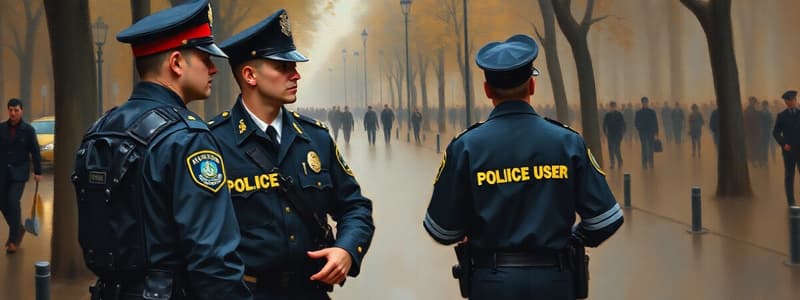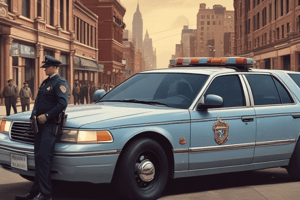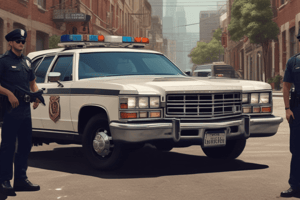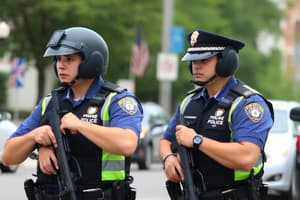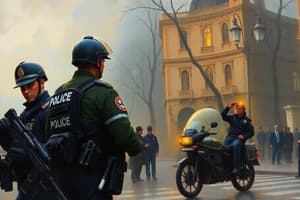Podcast
Questions and Answers
What are some ways you can get to know your community while on patrol? Why is this important?
What are some ways you can get to know your community while on patrol? Why is this important?
You can get to know your community by interacting with residents, attending community events, and observing the area's patterns. It's important because understanding your community allows you to build relationships with residents, recognize suspicious activity, and effectively respond to calls for service.
What are the primary purposes of patrolling?
What are the primary purposes of patrolling?
- Maintaining a public presence
- Enforcing laws and ordinances
- Deterring crime
- All of the above (correct)
What are the two main parts of community-oriented policing?
What are the two main parts of community-oriented policing?
- Community Partnerships (correct)
- Problem Solving (correct)
- Community engagement
- All of the above
Explain what a "roll call" is and what should be recorded at a roll call meeting.
Explain what a "roll call" is and what should be recorded at a roll call meeting.
Match the following patrol methods with their description
Match the following patrol methods with their description
Which of the following is NOT an advantage of foot patrol?
Which of the following is NOT an advantage of foot patrol?
What is the difference between cover and concealment?
What is the difference between cover and concealment?
While on duty, officers should prioritize their own safety over the safety of others.
While on duty, officers should prioritize their own safety over the safety of others.
Which of the following is NOT considered a component of situational awareness?
Which of the following is NOT considered a component of situational awareness?
Properly maintained equipment is a critical factor in officer safety.
Properly maintained equipment is a critical factor in officer safety.
Describe two ways to improve your observational skills.
Describe two ways to improve your observational skills.
The primary goal of BTAM is to predict future acts of targeted violence.
The primary goal of BTAM is to predict future acts of targeted violence.
Targeted violence is rarely planned and usually occurs impulsively.
Targeted violence is rarely planned and usually occurs impulsively.
What are the three core functions of BTAM?
What are the three core functions of BTAM?
A law enforcement officer can only use force to detain a person when a warrant has been issued.
A law enforcement officer can only use force to detain a person when a warrant has been issued.
Describe the importance of responding to non-criminal calls for service.
Describe the importance of responding to non-criminal calls for service.
Why is it important to maintain proper command presence when responding to non-criminal calls?
Why is it important to maintain proper command presence when responding to non-criminal calls?
What steps should officers take when responding to a welfare check?
What steps should officers take when responding to a welfare check?
Officers are always authorized to enter private property to conduct a well-being check.
Officers are always authorized to enter private property to conduct a well-being check.
A security check should be conducted through visual observation only.
A security check should be conducted through visual observation only.
What actions should officers take if they find evidence of criminal activity during a security check?
What actions should officers take if they find evidence of criminal activity during a security check?
When making a death notification, what is the most critical step to ensure professionalism?
When making a death notification, what is the most critical step to ensure professionalism?
It is always acceptable to notify the next of kin of a death through a telephone call.
It is always acceptable to notify the next of kin of a death through a telephone call.
Officers should avoid offering personal opinions or emotional support when delivering a death notification.
Officers should avoid offering personal opinions or emotional support when delivering a death notification.
Describe the importance of training and experience when responding to nuisance animal calls involving wildlife.
Describe the importance of training and experience when responding to nuisance animal calls involving wildlife.
What steps should officers take when responding to a vehicle fire?
What steps should officers take when responding to a vehicle fire?
Responding to a false fire alarm is considered a criminal offense.
Responding to a false fire alarm is considered a criminal offense.
What is the most important consideration when responding to an alarm call?
What is the most important consideration when responding to an alarm call?
It is acceptable to conduct a building search alone, without additional support.
It is acceptable to conduct a building search alone, without additional support.
Describe the importance of a perimeter during a search for a suspect.
Describe the importance of a perimeter during a search for a suspect.
What are the specific steps to take when responding to a ground search?
What are the specific steps to take when responding to a ground search?
When conducting a ground search for a suspect, officers should search every potential hiding place.
When conducting a ground search for a suspect, officers should search every potential hiding place.
What are the main factors to consider when deciding whether to pursue a suspect on foot?
What are the main factors to consider when deciding whether to pursue a suspect on foot?
Officers are legally permitted to pursue any fleeing suspect on foot.
Officers are legally permitted to pursue any fleeing suspect on foot.
Describe three factors that should be taken into consideration when deciding to end a foot pursuit.
Describe three factors that should be taken into consideration when deciding to end a foot pursuit.
It is not necessary to search an arrestee for weapons or contraband if a senior officer has already searched them.
It is not necessary to search an arrestee for weapons or contraband if a senior officer has already searched them.
What information must be provided to the booking officer when delivering an arrestee?
What information must be provided to the booking officer when delivering an arrestee?
Booking officers will also be responsible for collecting and processing any evidence found on the arrestee.
Booking officers will also be responsible for collecting and processing any evidence found on the arrestee.
It is critical to document arrests thoroughly because these documents will be used for evidential purposes and possibly in a future prosecution.
It is critical to document arrests thoroughly because these documents will be used for evidential purposes and possibly in a future prosecution.
Officers can transport a juvenile in the same vehicle as an adult arrestee, even if they are not codefendants.
Officers can transport a juvenile in the same vehicle as an adult arrestee, even if they are not codefendants.
When transporting an arrestee with a disability, what should officers do?
When transporting an arrestee with a disability, what should officers do?
Officers can transport a pregnant arrestee in the same vehicle as an adult arrestee, even if they are not codefendants.
Officers can transport a pregnant arrestee in the same vehicle as an adult arrestee, even if they are not codefendants.
When transporting an arrestee, it is acceptable to leave them unattended in a hot vehicle for an extended period.
When transporting an arrestee, it is acceptable to leave them unattended in a hot vehicle for an extended period.
Officers should always be on the lookout for additional obstacles or challenges during transport, such as the arrestee's size or medical condition, and adjust their procedures as needed.
Officers should always be on the lookout for additional obstacles or challenges during transport, such as the arrestee's size or medical condition, and adjust their procedures as needed.
When arriving at a detention facility, officers should always secure their weapons in the trunk of their patrol vehicle.
When arriving at a detention facility, officers should always secure their weapons in the trunk of their patrol vehicle.
Officers are responsible for ensuring the safety and well-being of the arrestee after turning them over to the detention facility staff.
Officers are responsible for ensuring the safety and well-being of the arrestee after turning them over to the detention facility staff.
It is acceptable to leave the transport vehicle unsecured after transferring an arrestee to a detention facility.
It is acceptable to leave the transport vehicle unsecured after transferring an arrestee to a detention facility.
It is important to minimize interactions between juveniles and adults in detention facilities, even if they are not codefendants.
It is important to minimize interactions between juveniles and adults in detention facilities, even if they are not codefendants.
It is acceptable to release a juvenile on their own recognizance, pending a court appearance.
It is acceptable to release a juvenile on their own recognizance, pending a court appearance.
Officers are always responsible for the safety and well-being of a juvenile in custody, even after notifying the parents or a legal guardian.
Officers are always responsible for the safety and well-being of a juvenile in custody, even after notifying the parents or a legal guardian.
Booking officers are not required to process any contraband seized from the arrestee.
Booking officers are not required to process any contraband seized from the arrestee.
It is appropriate for officers to contact the media directly regarding an arrest.
It is appropriate for officers to contact the media directly regarding an arrest.
Flashcards
Reactive Patrol
Reactive Patrol
Responding to a crime after it's already happened.
Proactive Patrol
Proactive Patrol
Preventing crime by having officers regularly present in an area.
Community-Oriented Policing
Community-Oriented Policing
Working with the community to address crime and related issues.
Community Partnerships
Community Partnerships
Signup and view all the flashcards
Problem Solving (Policing)
Problem Solving (Policing)
Signup and view all the flashcards
Duty Equipment Inspection
Duty Equipment Inspection
Signup and view all the flashcards
Roll Call
Roll Call
Signup and view all the flashcards
Patrol Area Familiarity
Patrol Area Familiarity
Signup and view all the flashcards
Suspicious Activity
Suspicious Activity
Signup and view all the flashcards
Cover
Cover
Signup and view all the flashcards
Concealment
Concealment
Signup and view all the flashcards
Observation Skills
Observation Skills
Signup and view all the flashcards
Situational Awareness
Situational Awareness
Signup and view all the flashcards
Maintaining Composure
Maintaining Composure
Signup and view all the flashcards
Maintaining Professionalism
Maintaining Professionalism
Signup and view all the flashcards
Officer Safety Assessment
Officer Safety Assessment
Signup and view all the flashcards
Responding to a BOLO
Responding to a BOLO
Signup and view all the flashcards
BOLO
BOLO
Signup and view all the flashcards
Contact Officer
Contact Officer
Signup and view all the flashcards
Cover Officer
Cover Officer
Signup and view all the flashcards
Study Notes
Patrol Basics
- Patrolling is the main daily activity for law enforcement officers
- Community-oriented policing is a crucial part of daily patrol, building partnerships with the community
- Reactive patrol responds to incidents after they occur, while proactive patrol discourages crimes in a given area by a regular presence
- Building community relationships is important for gathering information
- Officers must be familiar with their assigned patrol area to respond quickly and efficiently
Studying That Suits You
Use AI to generate personalized quizzes and flashcards to suit your learning preferences.
